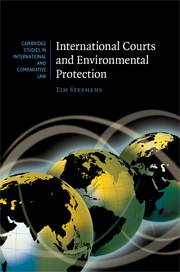Book contents
- Frontmatter
- Contents
- Foreword
- Acknowledgements
- List of tables
- List of figures
- List of abbreviations
- Table of cases
- Table of treaties and other international instruments
- CAMBRIDGE STUDIES IN INTERNATIONAL AND COMPARATIVE LAW
- 1 Introduction
- Part I International courts and environmental governance
- 2 The patchwork of jurisdictions
- 3 Institutions of international environmental governance
- 4 International courts and environmental governance
- Part II Judicial development
- Part III Contemporary challenges
- Bibliography
- Index
3 - Institutions of international environmental governance
from Part I - International courts and environmental governance
Published online by Cambridge University Press: 21 August 2009
- Frontmatter
- Contents
- Foreword
- Acknowledgements
- List of tables
- List of figures
- List of abbreviations
- Table of cases
- Table of treaties and other international instruments
- CAMBRIDGE STUDIES IN INTERNATIONAL AND COMPARATIVE LAW
- 1 Introduction
- Part I International courts and environmental governance
- 2 The patchwork of jurisdictions
- 3 Institutions of international environmental governance
- 4 International courts and environmental governance
- Part II Judicial development
- Part III Contemporary challenges
- Bibliography
- Index
Summary
Compliance is now widely seen as the overriding governance objective in international environmental law. This priority rests on the premise that environmental law is now in a post-ontological era in which an extensive body of law requires immediate and effective implementation to halt the continuing global environmental decline. This enthusiasm for norm enforcement over norm generation is sometimes misplaced, because in some situations compliance with environmental regimes does not equate with regime effectiveness. Many environmental regimes set such modest goals that full compliance cannot address the underlying environmental problem, whereas partial compliance with more ambitious regimes can produce better than expected outcomes. A related complication is that the structure of environmental problems varies substantially and this differentiation is a key variable in the effectiveness of environmental regimes. Despite these caveats, which go to meta-questions of institutional design, compliance remains an important objective not only because it often correlates with better levels of environmental protection, but also because it improves environmental governance by maintaining the credibility of environmental regimes, which in turn can be a catalyst for deeper international cooperation.
Accepting the compliance imperative, the question of which institutions are best able to achieve it remains. In this respect international environmental law has been a field for substantial institutional experimentation and innovation. When public international law first acquired norms of an environmental character, these were enforceable (as with other rules of international law) through the traditional mechanisms of state responsibility and dispute settlement.
- Type
- Chapter
- Information
- International Courts and Environmental Protection , pp. 63 - 90Publisher: Cambridge University PressPrint publication year: 2009

